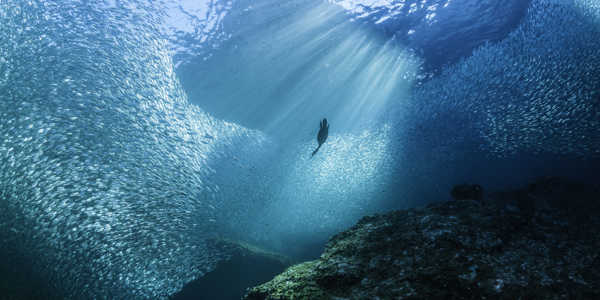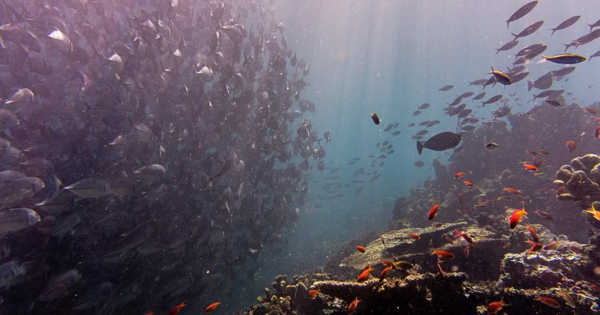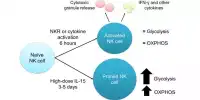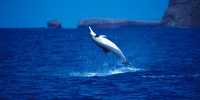A new system for sampling DNA fragments from drifting marine organisms in the ocean is set to open up new avenues for biodiversity research and ways to support conservation efforts. The results revealed that the DNA traces in the ferry-collected samples came from all parts of the vertebrate ecosystem, from small prey fish at the bottom of the food chain, such as anchovies and sardines, to small and larger predatory fish, such as tuna and swordfish, all the way up to dolphins and ocean giants, such as fin and sperm whales.
Over the last decade, biodiversity researchers have increasingly used DNA sequences extracted from environmental samples such as soil, marine, and freshwater, and even air – known as environmental DNA (eDNA) – to identify organisms found in a wide variety of habitats.
Sequencing these minute traces of DNA has proven to be a powerful technique for detecting elusive species that are only rarely observed directly or in early life stages when they are difficult to identify, revolutionizing biodiversity discovery and monitoring.
Researchers from the University of Leeds and the University of Milano-Bicocca in Italy have developed an innovative new method for collecting marine eDNA samples that has the potential to revolutionize biodiversity monitoring in remote offshore ocean locations.
A new system for sampling fragments of DNA from marine organisms drifting in the ocean is set to create new opportunities for research on biodiversity and ways of supporting conservation activities.
The team has created a novel system for easy sampling that can be deployed from ocean-going ferries and other commercial vessels such as container ships, allowing the global commercial shipping fleet to be used to help monitor marine biodiversity.
Although DNA sequencing is becoming more affordable by the year, the most difficult challenge is often collecting samples across large geographic areas required to scale up these new monitoring techniques to a global reach.
Sampling marine eDNA far from land typically requires access to dedicated research vessels, which are complex and costly to operate. These logistical constraints limit the geographic scope and frequency of surveys, limiting the growth of large-scale eDNA surveys.
The new system does not necessitate the deployment of complex equipment from a ship; water is collected from the engine cooling system using simple apparatus that can be performed by non-specialists. Because commercial vessels regularly cross remote corners of most of the world’s oceans, they could provide nearly limitless opportunities for sample collection to help biodiversity monitoring programs.

The team worked with the company Corsica-Sardinia Ferries to test the system on their route between Livorno in Tuscany and Golfo Aranci in Sardinia, which supports a long-term visual survey program for cetaceans run by ISPRA (Italian Institute for Environmental Protection and Research; also a partner in the current study).
The results revealed that the DNA traces in the ferry-collected samples came from all parts of the vertebrate ecosystem, from small prey fish at the bottom of the food chain, such as anchovies and sardines, to small and larger predatory fish, such as tuna and swordfish, all the way up to dolphins and ocean giants, such as fin and sperm whales.
Dr. Simon Goodman of the University of Leeds’ School of Biology is a co-lead author on the report, which was published in Frontiers in Marine Science. He stated: “I was astounded by how well the sequencing results captured the structure of the vertebrate ecosystem when we first started digging into them. It’s an exciting result that demonstrates eDNA’s ability to reveal fine-scale ecological variation.”
Dr Elena Valsecchi of the University of Milano-Department Bicocca’s of Environmental and Earth Sciences, one of the study’s leaders, stated: “This novel approach to environmental DNA allows us to perform a CAT (computerized axial tomography) scan of the sea. Following that, we will scan multiple ferry routes in the Mediterranean to create a high-resolution “image” of the state of biodiversity in our seas.”
Overall, eDNA from 100 distinct vertebrate species was discovered, with the species composition proving to be a good match for that known from conventional survey techniques in the Mediterranean. Furthermore, the team discovered fine scale variation in species occurrence related to environmental factors, such as how the relative abundance of anchovy and sardine sequences correlated with the different water temperatures the species are known to prefer for spawning.
Deep-sea sequences, such as lantern fish, were more common at night for some samples, corresponding to the daily vertical migrations through the water column that such bathypelagic species are known to make.
















